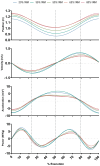Half Squat Mechanical Analysis Based on PBT Framework
- PMID: 40564419
- PMCID: PMC12189782
- DOI: 10.3390/bioengineering12060603
Half Squat Mechanical Analysis Based on PBT Framework
Abstract
Muscular strength is an essential factor in sports performance and general health, especially for optimizing mechanical power, as well as for injury prevention. The present study biomechanically characterized the half squat (HS) using a systemic structural approach based on mechanical power, called Power-Based Training (PBT), through which four phases of the movement were determined (acceleration and deceleration of lowering and lifting). Five weightlifters from the Mexican national team (categories U17, U20, and U23) participated, who performed five repetitions per set of HS with progressive loads (20%, 35%, 50%, 65%, and 80% of the one repetition maximum). The behavior of the center of mass of the subject-bar system was recorded by photogrammetry, calculating position, velocity, acceleration, mechanical power, and mechanical work. The results showed a significant reduction in velocity, acceleration, and mechanical power as the load increases, as well as variations in the duration and range of displacement per phase. These findings highlight the importance of a detailed analysis to understand the neuromuscular demands of HS and to optimize its application. The PBT approach and global center of mass analysis provide a more accurate view of the mechanics of this exercise, facilitating its application in future research, as well as in performance planning and monitoring.
Keywords: exercise biomechanics; half squat; mechanical power; power-based training.
Conflict of interest statement
The authors declare that they have no conflicts of interest.
Figures


Similar articles
-
Health professionals' experience of teamwork education in acute hospital settings: a systematic review of qualitative literature.JBI Database System Rev Implement Rep. 2016 Apr;14(4):96-137. doi: 10.11124/JBISRIR-2016-1843. JBI Database System Rev Implement Rep. 2016. PMID: 27532314
-
A rapid and systematic review of the clinical effectiveness and cost-effectiveness of paclitaxel, docetaxel, gemcitabine and vinorelbine in non-small-cell lung cancer.Health Technol Assess. 2001;5(32):1-195. doi: 10.3310/hta5320. Health Technol Assess. 2001. PMID: 12065068
-
Home treatment for mental health problems: a systematic review.Health Technol Assess. 2001;5(15):1-139. doi: 10.3310/hta5150. Health Technol Assess. 2001. PMID: 11532236
-
Physical exercise training interventions for children and young adults during and after treatment for childhood cancer.Cochrane Database Syst Rev. 2016 Mar 31;3(3):CD008796. doi: 10.1002/14651858.CD008796.pub3. Cochrane Database Syst Rev. 2016. PMID: 27030386 Free PMC article.
-
Effect of Resistance Training Frequency on Gains in Muscular Strength: A Systematic Review and Meta-Analysis.Sports Med. 2018 May;48(5):1207-1220. doi: 10.1007/s40279-018-0872-x. Sports Med. 2018. PMID: 29470825
References
-
- Quiceno C., Mantilla J.I.A., Samudio M.A., Arévalo J.C. Caracterización de Fuerza de Cadena Muscular Anterior y Posterior En Futbolistas Colombianos, Categorías U17 y U20. VIREF Rev. Educ. Física. 2020;9:38–47.
-
- Aliaga Reynaldo J.R., Núñez Aliaga F. Distribución del volumen de trabajo de la fuerza muscular en atletas del área de velocidad del atletismo (Original) Olimp. Publ. Científica Fac. Cult. Física Univ. Granma. 2016;13:192–201.
-
- Rosa-Guillamón A., García-Cantó E. Relación entre fuerza muscular y otros parámetros de la condición física en escolares de primaria. SPORT TK-Rev. Euroam. Cienc. Deporte. 2017;6:107–116. doi: 10.6018/280511. - DOI
-
- Fernandez Ortega J.A., Hoyos Cuartas L.A. Efectos de La Velocidad de Entrenamiento En Fuerza Sobre Diversas Manifestaciones de La Fuerza En Mujeres Adultas Mayores (Effect of the Velocity Resistance Training on Various Manifestations of Resistance in Older Women) Retos. 2020;38:325–332. doi: 10.47197/retos.v38i38.73917. - DOI
-
- Registre F., Lopes L.M.P., Souza P.M., Becker L.K., de Alcantara Borba D., Ferreira Júnior J.B., de Oliveira E.C., Coelho D.B. Effects of Different Strength Training Protocols on Sarcopenia Influencing Parameters in Older Adults: A Systematic Review. ABCS Health Sci. 2022;47:e022308. doi: 10.7322/abcshs.2020231.1683. - DOI
LinkOut - more resources
Full Text Sources

